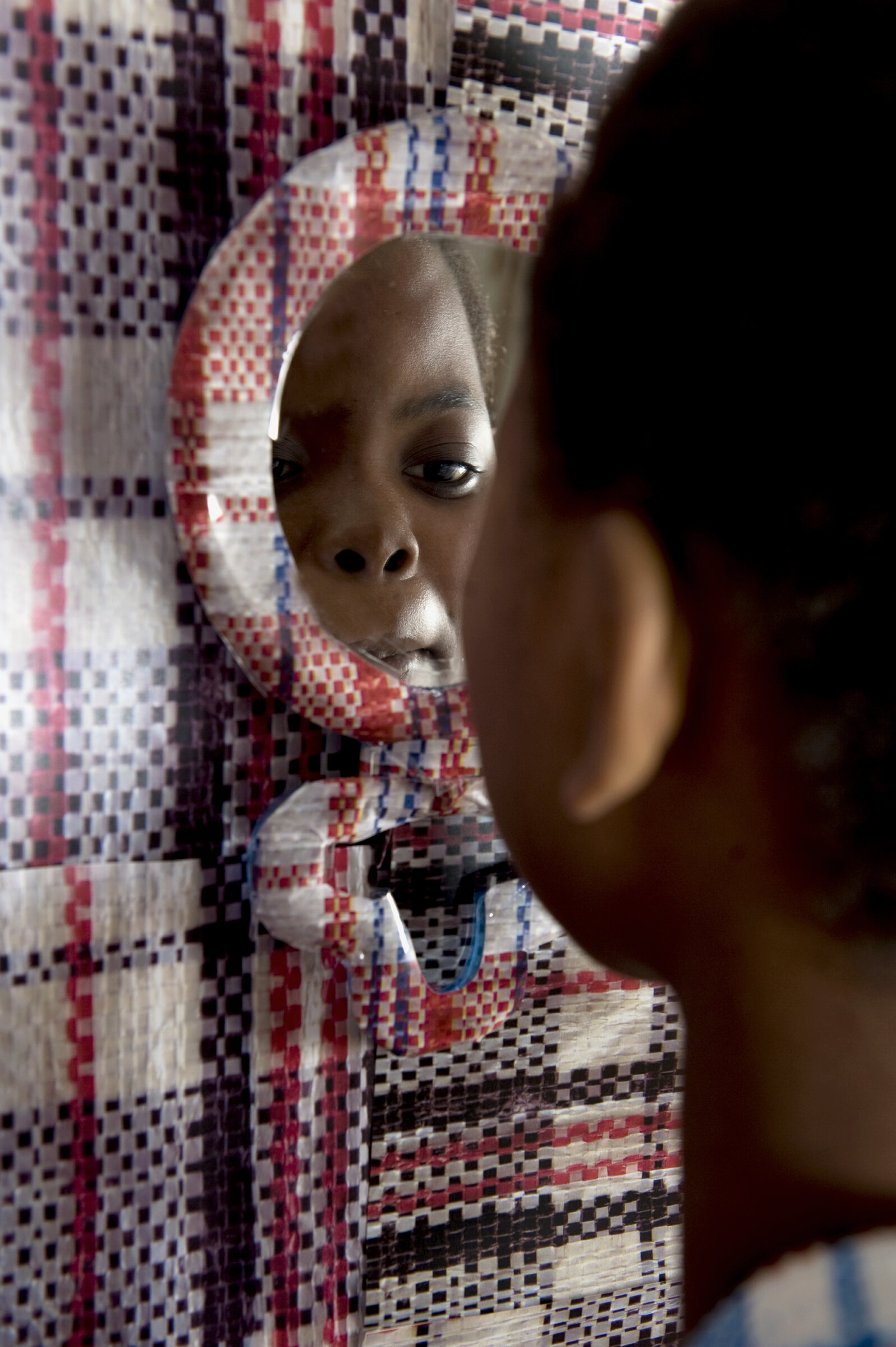Exploring womanhood with Azania FOREST
Is there one way to describe Azania Forest and her work ? - Is this actually necessary to do so ? - The self taught photographer and mix media artist takes us on a unique trip to explore the diversity of her world.
Is there one way to describe Azania Forest and her work ? - Is this actually necessary to do so ? - The self taught photographer and mix media artist takes us on a unique trip to explore the diversity of her world. The South African artist is part of a vibrant generation of creatives who creates the magic by piling up inspirations, influences and identities. Navigating through her rich cultural heritage within a modern society, she explores the deep meaning of being a black woman and its stigmas but also the single representation of masculinity : strong, hard, violent sometimes. An invitation to a vibrant and unapologetic vision starting with the name she has given herself :
Azania FOREST : I went with this name because Azania is a Hebrew name meaning ‘God listens’, it is also a name that is used to refer to some portions of Southern Africa. I resonate with this name because I come from Southern Africa and I believe that I am guided by the God of my forefathers. This name reminds me of where I come from and where I am going. ‘Forest’ reinforces ‘Azania’ because a forest is home to many living creatures, it is not man made and it is filled with the wonders of life and nature. Azania Forest is a name that means surrounding to God because I am not in control, it reminds me of the people that got me here and the person I am constantly becoming.
M.A : Is it important for you to have an alias ?
A.F : Not necessarily, I love my legal name, but I also love the name that I have given myself. I embrace the name that my parents gave me, and I also embrace the name I have given myself. It was an empowering act, a moment where I validated the relationship I have with myself.
M.A : You have been exploring with photography but also painting, collage and more recently clothing, what is guiding you ?
A.F : I could say that I am multifaceted, I do feel that I have been endowed with the ability to express my thoughts through various mediums. I am an aspiring visual artist and trained fashion designer. I also work as a fashion stylist and photographer. I approach all of these fields with intuition. I always have a story to tell and sometimes the best way to tell it may be through fashion instead of painting, sometimes the story needs me to paint instead. Each medium serves a different story.
M.A : How confident have you been about taking this road ?
A.F : I have always had an affinity for arts since childhood. I loved sounds, colours, shapes and scents. I have always been a more sensory person and I understand information through symbolism and figurative language. My confidence comes from understanding that this is how my brain works and art is my way of communication.
” Being a black woman is easy, but it becomes difficult because of the society we live in. Our experiences collectively are layered, complex and nuanced. I want us to be represented more, as humanely as possible.“
M.A : Whether it is collages, clothes, photographs, your work suggests lots of exploration and expression of identity, especially as a woman ?
A.F : Yes it does. Being a black woman is easy, but it becomes difficult because of the society we live in. Our experiences collectively are layered, complex and nuanced. I want us to be represented more, as humanely as possible. I explore this identity because I want the lives of black women to be better, I want our voices to be heard and stories to be told.
M.A : What about the Mbona Lisa series and your series about the stigma of menstruate, what was your outlook on this ?
A.F : Mbona Lisa is an ongoing body of work, however, I have decided to be slow with its process because I want to articulate her story in a substantial way. The Mbona Lisa series speaks to the parallels of black land ownership and black women having autonomy over their identities and bodies. Land is a resource that provides food and space for shelter, in the same breadth, women are mostly imposed with the task of mothering and housing children. Mbona Lisa wishes to question these imposed roles of womanhood and how women define themselves. Mbona Lisa also alludes to the Mona Lisa by Leonardo Da Vinci, who was considered a ‘virtuous’ woman. It speaks to colonial impositions of what womanhood entails.
Menstrual Purity (the series was created in 2017) speaks on the process of how an unfertilised egg dies, which leads to menstruation. It is illogical how bodies that menstruate, mostly women, have been made to carry the stigma of non-cleanliness whereas this a biological process that can symbolise the process of death and re-birth. There is an underlying power in understanding this process as a way of looking at life and seasons. There are seasons of release and seasons of intake, seasons of movement and rest. I wish to eventually sell the portraits and use the profits to help women and girls experiencing period poverty.
M.A : Is it still hard to be a woman ?
A.F : I don’t believe that it is hard to be a woman, it is the world that makes our living experiences hard. I want women to be proud of being who they are despite the external injustices, we are more than our struggles.
M.A : Still there is poetry in those shots, how would you define your style ?
A.F : My style and artistic practice is inspired by my identity as an African and as a woman. I do photographic portraiture and I have recently gone into traditional art whilst maintaining portraiture. I want black people to document themselves and create archives for future generations because our history has mostly been manipulated and somewhat erased. My style is self-documentation and the construction of one’s identity.
M.A : …and this is not limited to womanhood.
A.F : Soft Masculinity is inspired by the position of black men in South Africa, they are the biggest group of perpetrators regarding gender based violence and rape. In this work I wish to deconstruct how patriarchy is a double edged sword for men and how it essentially harms them in the greater scheme of things. Which is why I portrayed them in a way that is abstract from patriarchal behaviour – intimate and ‘soft’. I wish for them to do self introspection as to why vulnerability and intimacy amongst each other is viewed as a weakness. Soft Masculinity is a call for men to question internalised patriarchal behaviour and how that leads to misogyny.
As she likes exploring diverse paths, Azania is also one half of Camagu Studio she founded with fellow artist and creative Lulama WOLF :
A.F : Camagu is a Xhosa word meaning ‘to honour’. Camagu Studio is a collaborative concept company founded by myself and Lulama Wolf. We are both visual creators and Camagu Studio is a space for us to explore our artistic practices. We wish to honour our heritage by archiving our cultural artefacts and documenting our present realities for future generations. We are aware of how fast and how Western the world is becoming, and our wish is to honour the people that brought us here and protect cultural practices that are rooted in the betterment of African people.
M.A : Where is your head this days ?
A.F : I am currently working on a fashion collection for my clothing line Lesego Seoketsa; and in the design process. It is an exciting part of my life because I love fashion as a medium of self expression. My team and I are researching ways to make our products environmentally sustainable and long lasting.
M.A : How have you been lately ? How has current global context affected you ?
A.F : The current pandemic is very difficult because I have to imagine different ways of working with people. As a photographer and stylist I now have to make sure that conditions are safe for working, and it causes anxiety because I don’t want anyone to be at risk. The lockdown has lead me to find new inspiration and different ways to create at home, which is why I have picked up painting. I am also shooting more self portraits in my backyard. Things have slowed down, however I cannot stop, I have no other choice but to continue working.
Interview by Mayi-Arts. All works are courtesy of Azania FOREST.
In conversation with Nobukho NQABA
Nobukho Nqaba tells her story about migration and being a foreigner in South Africa using China mesh bags and daring performances
We met with South African visual artist and performer Nobukho Nqaba. We discuss work, education and views on migration and what it means to be a foreigner even to your own country.
Nobukho NQABA, Ndiyayekelela
Mayi.Arts : How do you define your work ?
Nobukho NQABA : I would say my work is performative, but uses elements of self portraiture while addressing personal and broader issues of people who come from or are from marginalised communities in South Africa, more especially the working class.
M.A : One of our first focus stories is about migration, what does this evokes you ?
N.N : Migration is broadly understood as movement of people, themes of displacement, searching and looking for something better comes to my mind when I think about migration. While others choose to migrate and they have the means to do so, other people are forced to do so because of war, poverty , etc. One thing that we can all understand when it comes to migration is that one identifies a lack of something, and they set about finding ways to address that lack or need by moving to spaces that are potentially going to give them a “better” life.
M.A : Self portrait is prevalent mean of expression in your work, which is a very intimate form of portraying : you and a camera. How did you start being involved in photography ?
N.N : I studied photography at the Michaelis School of Fine Art (University of Cape Town). I had never been in a darkroom before or processed images using chemicals. My family does not even have photographs of us when we were young. I was so drawn into the medium , both from a curious point of view, but also for making sure that I make my presence felt by using an analogue or digital footprint of my face. Almost making up for lost time.
People respond to different visual forms, a photograph evokes a strong permanent stance, one that will last forever and can be reproduced.
Nobukho NQABA
M.A : ... But you also do performances, in which you are object and subject through the eye of people and the way they interact with you,
N.N : When I perform, I am extending from the stillness of the photograph. I want to bring what is frozen to life. People respond to different visual forms, a photograph evokes a strong permanent stance, one that will last forever and can be reproduced. While a performance is often a moment in time that is unfrozen, it is restless, moves and often evokes something from the subconscious mind. Although using the body, it is abstract in a way, it is driven by feeling and movement. I think both photography and performance complement each other, because each borrows from one another.
M.A : We are referring here to your performance in front of V&A waterfront as part of Ndiyayekelela. A striking element was the different reactions of people. How comfortable were you during this performance ?
N.N : I am always nervous when I start performing, because one never knows what kind of a reaction they will get from the audience. It was the same case for the said performance, however, I had a message that I wanted to bring across, and I wanted people to see it. What kept me going was to switch of mentally and not think of the people around me, but focus on what I was doing, as if it was just me and my objects in space.
M.A : Is this a parallel of how society behaves towards the working class which is dominant but at the same time invisible ?
N.N : Probably yes, the working class footprint is everywhere in the city, but they are often overlooked, as if they do not matter. A lot of people just do not stop to think about, the labour that they do, nor their experiences, or the fact that a lot of them build beautiful architectural structures , but they themselves live in shanty towns where they do not have enough space, and are unable to build for themselves because they earn so little. Or that domestic workers leave their children to go to work in the early hours of the day, taking care of other people’s children while theirs are left alone. Often the eldest being the one who has to take care of other siblings, leaving a broken family structure, where the parents come home late…after having left early, and there's no reflection on the day's work. The cycle carries on, and this results in dysfunctional families. The examples are endless...
“ With that particular performance, people stopped and stared, others asked questions and others just simply carried on with their shopping. Other people asked if they could bring their own laundry for me to do. ”
M.A : What were the intents behind this performance and the whole series ? Did people actually interacted with you ?
N.N : The performance was in two parts. The first part was when I walked around the V&A waterfront wearing the China bag, and standing at a frame that shows Table Mountain (an area where lots of people take pictures/ selfies). I received some unpleasant responses from some people, this includes being called a thing. And I recall a tourist who wanted me to move so that they can have their picture taken, said to me “she is fucking African, she cant understand English”. A woman also physically touched me on my chest telling me of how selfish I was for standing at the table mountain frame longer.
The second part was when I washed the overalls in front of the shop, and hung them on a washing line. With that particular performance, people stopped and stared, others asked questions and others just simply carried on with their shopping. Other people asked if they could bring their own laundry for me to do.
The performances were for me to ask Cape Town, especially the waterfront to recognise that hard labour from the working class made it what it is. I wanted to make the working class visible. I also wanted to highlight the fact that those who enjoy the luxurious waterfront are often people who are not from South Africa, hence I was wearing the china bag in the first part. That they are themselves foreign to the space, however the space is also foreign even to those who take care of it. The V&A waterfront is such a weird space for me to be in. It’s one of the areas that i feel very much removed from, that it is in my country, but yet it is also not built for a person with my background, except for a tiny section there, where you will find affordable food shops. It is a space that is screaming of social stratification in terms of class, and affordability.
M.A : In the past you discussed the notion of being a foreigner occurrences in which you have been called such and even a kaffir this the fate of each who migrates ? To be a forever nomad ?
N.N : Yeah... the term foreigner in my context is often used to refer to someone who was not born in the country they are in. A lot of people in South Africa refer to other people who come from other countries as foreigners. This is a negative word, because it discriminates against fellow African people. Being foreign is associated with certain stereotypes, how one speaks and how one looks. I was called a foreigner once by a group of men, who were cat calling me on my way from work. Because I did not reply to their advances, they decided to insult me, and I remember one of them saying “Can’t you see she is a foreigner”, she cant even hear us.
Which also makes me think of when I was in art school, and one of the car guards on the street across campus, always told me that I am Congolese. He was certain that I am from Congo, because I looked a certain way and he kept saying he saw me somewhere. It did not help telling him that I do not understand French, and that I can only speak English and in Xhosa. He thought I was ashamed of being a “foreigner”.
Often being originally from the Eastern Cape , and residing in Cape Town, in times of tensions Eastern Cape people are sometimes told to go back to the rural areas. This is further fuelled by some politicians, one in particular called people from the Eastern Cape who reside in Cape Town “refugees”.
The word Kaffir was was used by the Apartheid government to refer to black South Africans. It is now a banned word to use in South Africa, however, some racist white South Africans still use it to speak down on black south africans or to make them feel inferior. Yes, I was called that word and it made me angry because that word is discriminatory.
These experiences made me think really hard about what it means to be an ‘other’ or to be considered foreign. There are so many layers to unpack, which obviously include certain stereotypes, which are harmful.
M.A : As it is also part of your personal story ...
Yes, from a personal level and from a professional practice, especially the work that I did in 2012 (Umaskhenkethe Likhaya lam), I looked at migration within one's own country of birth. In my case (family), moving from the Eastern Cape to the Western Cape, and the experiences that come with that. I mostly focus on objects, memory and symbolism to make work about my personal experiences.
M.A : Which brings us to Umaskhenkethe, as a reference, those bags didn’t really have a name in some countries, in France for example, they’d be referred to as ‘Tati Bags’ [name of the store where a lots were sold ]and commonly ‘Barbès Bags’ [Barbès used to be the multicultural district of Paris ] , they had a really negative perception. aCarrying those bags because meant fresh out of your country and not integrated yet but also poor.
Was it important for you to rewrite the story of these bags and their narratives as they are part of the most African households ?
N.N : it is interesting that in France those bags are associated with a space that is full of migrants. This speaks volumes about how this bag is a global symbol of migration, and at least from a migrant perspective as a symbol for the working class and of those who belong in a certain social stratum in society.
For me it is important to take these objects and symbols and make them visible. I am taking the “in your face” kind of approach, that these objects, practically and symbolically need to be seen, doing so to make the people who use them visible. Symbolically elevating them from being overlooked.
M.A : Watching this series we can see the mesh bags being used as a bag, a pillow, wallpaper, what was the starting point of this extensive work ? What was the process ?
N.N : I started off by having conversations with people in Cape Town about their associations with the bags. I got a lot of interesting stories, and I then dug deep into what I was so drawn into this back, and I realised how similar my story was to that of the people I had interviewed. It was a difficult and long process, one which required listening, contemplating and making a visual output.
Working with the material was challenging, because it is hard plastic, and does not fold like a normal fabric. I have had to cut the bags up, flatten them so that they can at least have some sort of flexibility, and I had to improvise in some areas, where I used colour scans of the bag, printed them on paper and used them.


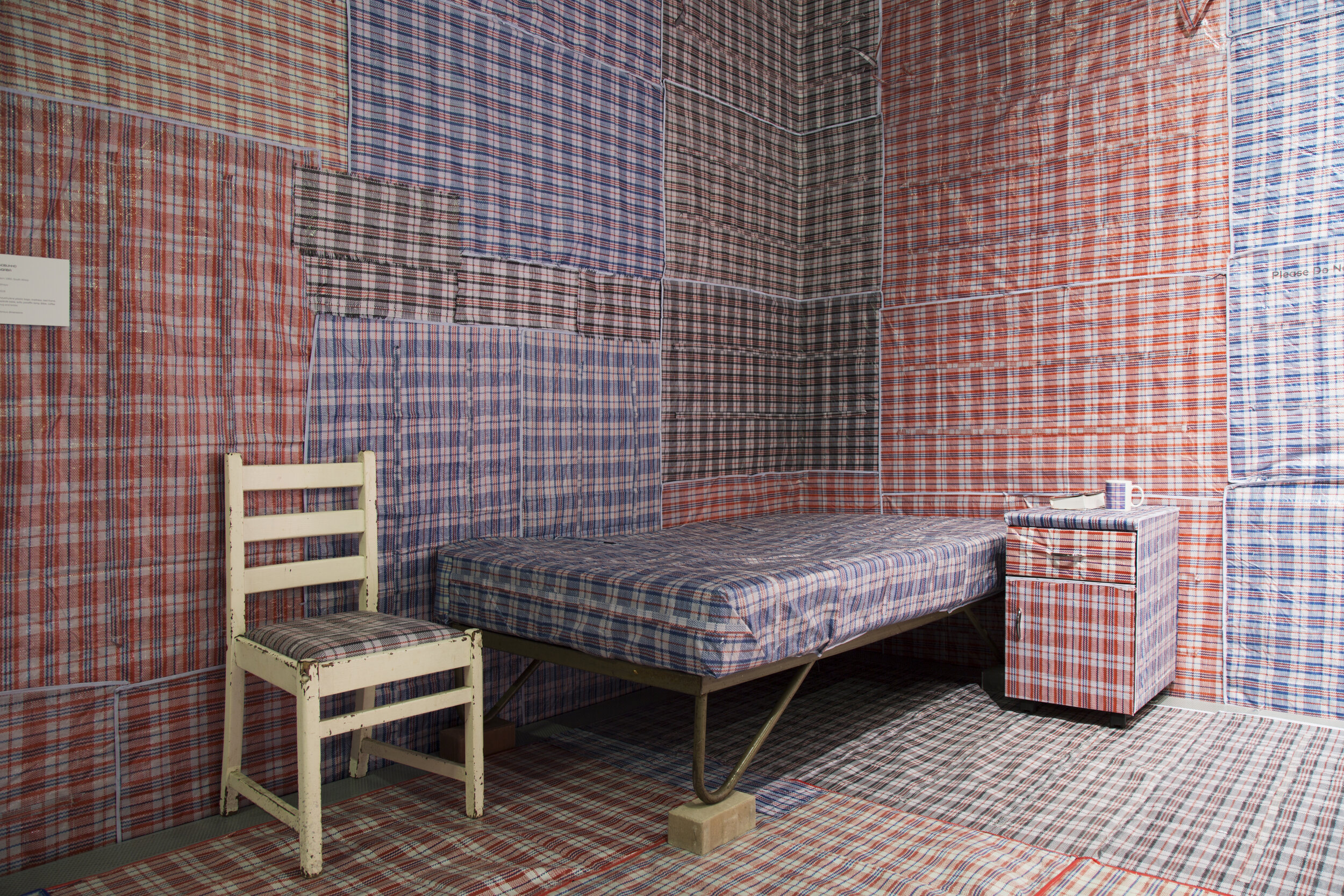
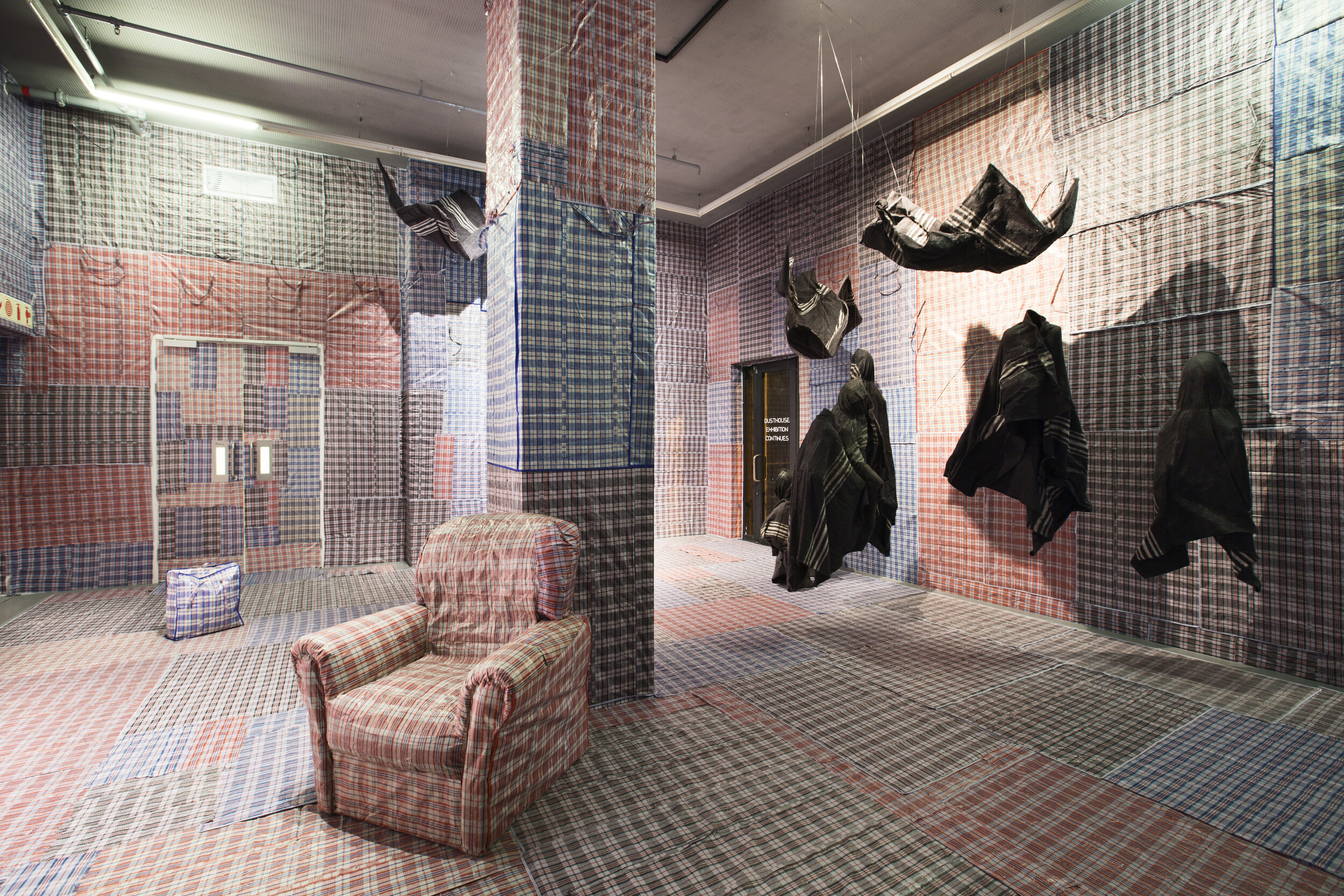
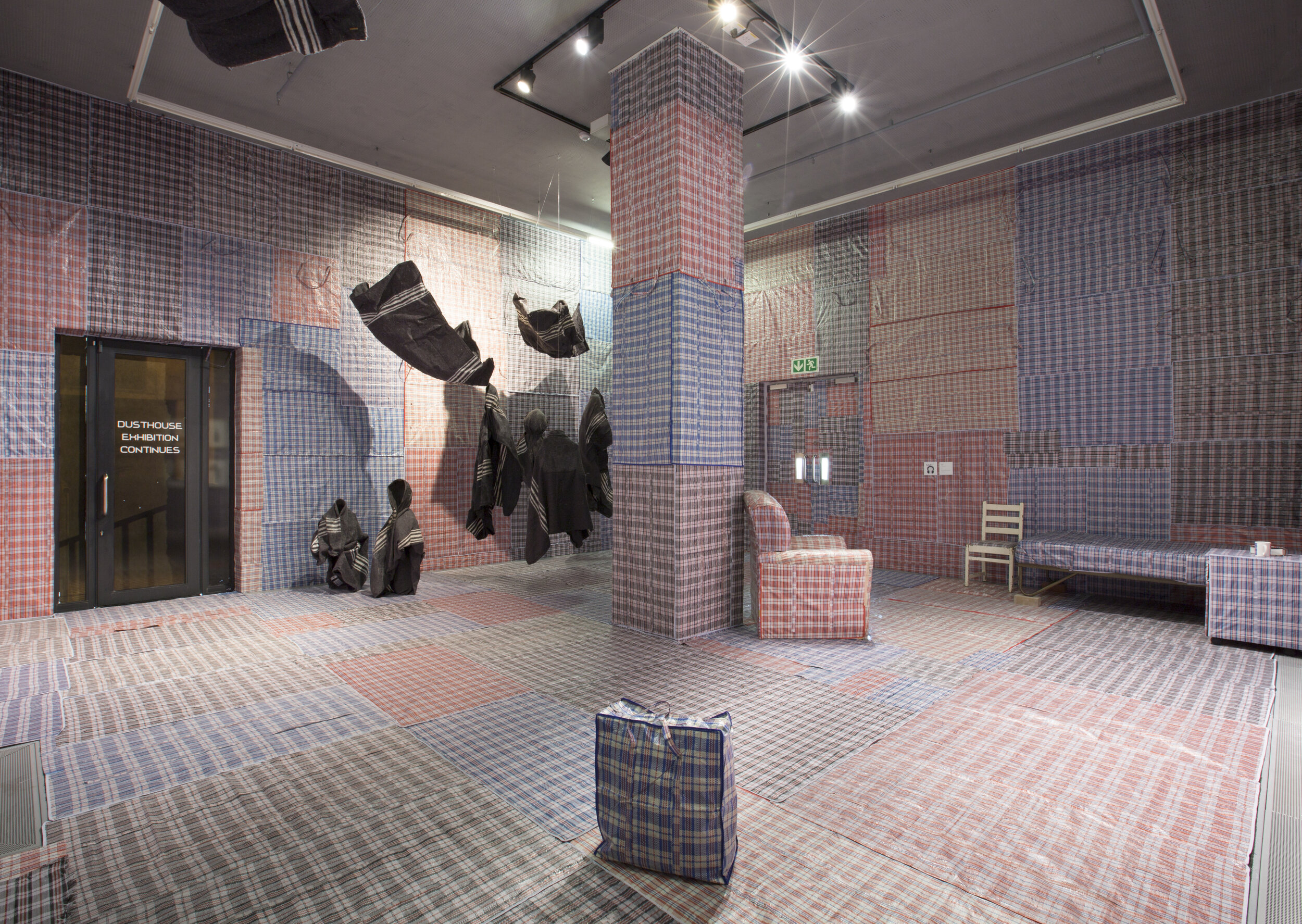


M.A : In the past you mentioned observing people as a source of inspiration, what else inspires you ?
I am still inspired by people, and how they interact with one another. I am also inspired by fellow artists who are investigating, deconstructing and exploring similar themes as me.
M.A : Would you define yourself as an activist ? Is it important for you to guide people in their interpretation of your
work ?
I do hope that the work that I do makes people think beyond, about society’s issues. I really hope that one day things will change and be better for most. I am an activist? I do not know, it depends on how one understands that word. What I do know is I am making work about issues that are close to my heart, and issues that matter.
I always say that my work provides a framework of broader societal issues, however it is not a deciding factor. People must look at it , and insert their own selves in the issues that I address. I am not guiding them, but I am simply asking them to look around what's happening, and that something needs to change in the way that we deal with each other.
M.A : When did you decide to become an artist? Was this your first calling, can you tell us about your path ?
N.N : Probably since high school. I always wanted to be either a social worker or an artist. but i realised that I feel much more at peace when I express myself creatively.
M.A : Tell us more about being a woman artist in South Africa, what is the scene these days
N.N : Things are slowly moving, we have seen a few female artists being visible and exhibiting. But there is still a long way, the art scene is still very male dominated. Female artists are pushing, and they are not waiting on establishments to discover them, they form their own collectives and encourage each other, and that is a beautiful thing. There is a strong sense of empowerment, and care that we give each other as females.
M.A : You lecture as well...
N.N : Yes, I lecture photography at one of the tertiary institutions in Cape Town. It has been a year now, and I am really enjoying it. Prior to that I was teaching Visual Arts, and digital photography for five years at one of the local art centres in Cape Town. I have always been doing some teaching while being a practicing artist at the same time. I believe in the power of art education, and teaching is one of the things that I enjoy. and I think for me both being an artist and a teacher is paramount, none overtakes the other. I believe that I am teaching people through my art, and I have a duty to educate the next generation of artists as well, hence i do both.
M.A : What is your favourite artwork of yours ?
I don't really know which one... (laughs) ! Some days I like a particular work, and other days I do not like it that much. I am constantly thinking of ways to make the best work, and thinking
M.A : Any upcoming work, work in progress ? How do you keep your peace as covid-19 has changed many aspects of our lives ?
N.N : I have been using this time to teach, and to reflect on what is happening around the world. I have not committed to making new work, it takes me a long time to make work. i spend a lot of time just thinking things through, and when i feel that the time is right, then i produce.
M.A : Where do you feel home now ?
N.N : For me home is where I am with people I love. I am in a good space with my family, and I think that is just good enough for me.
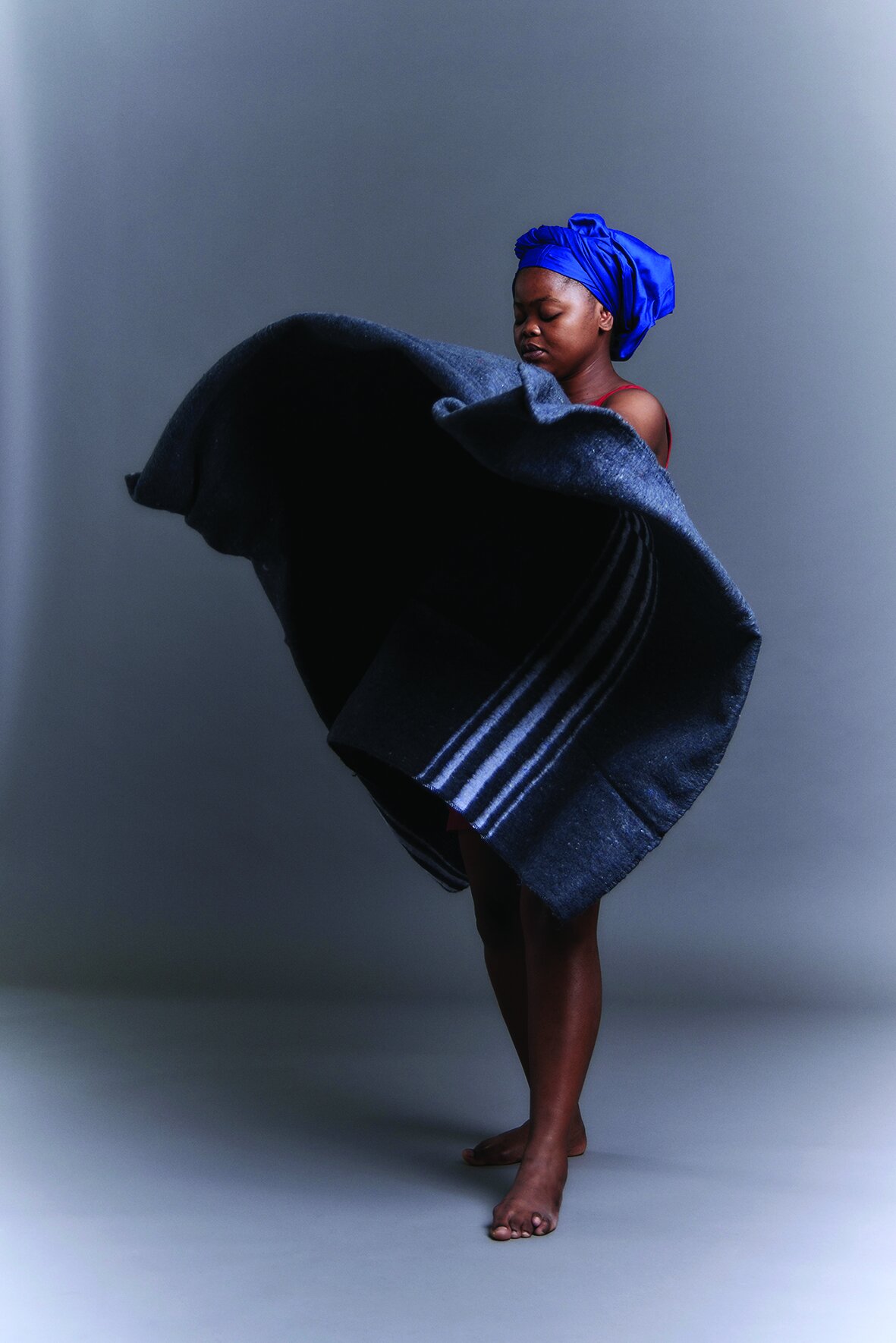
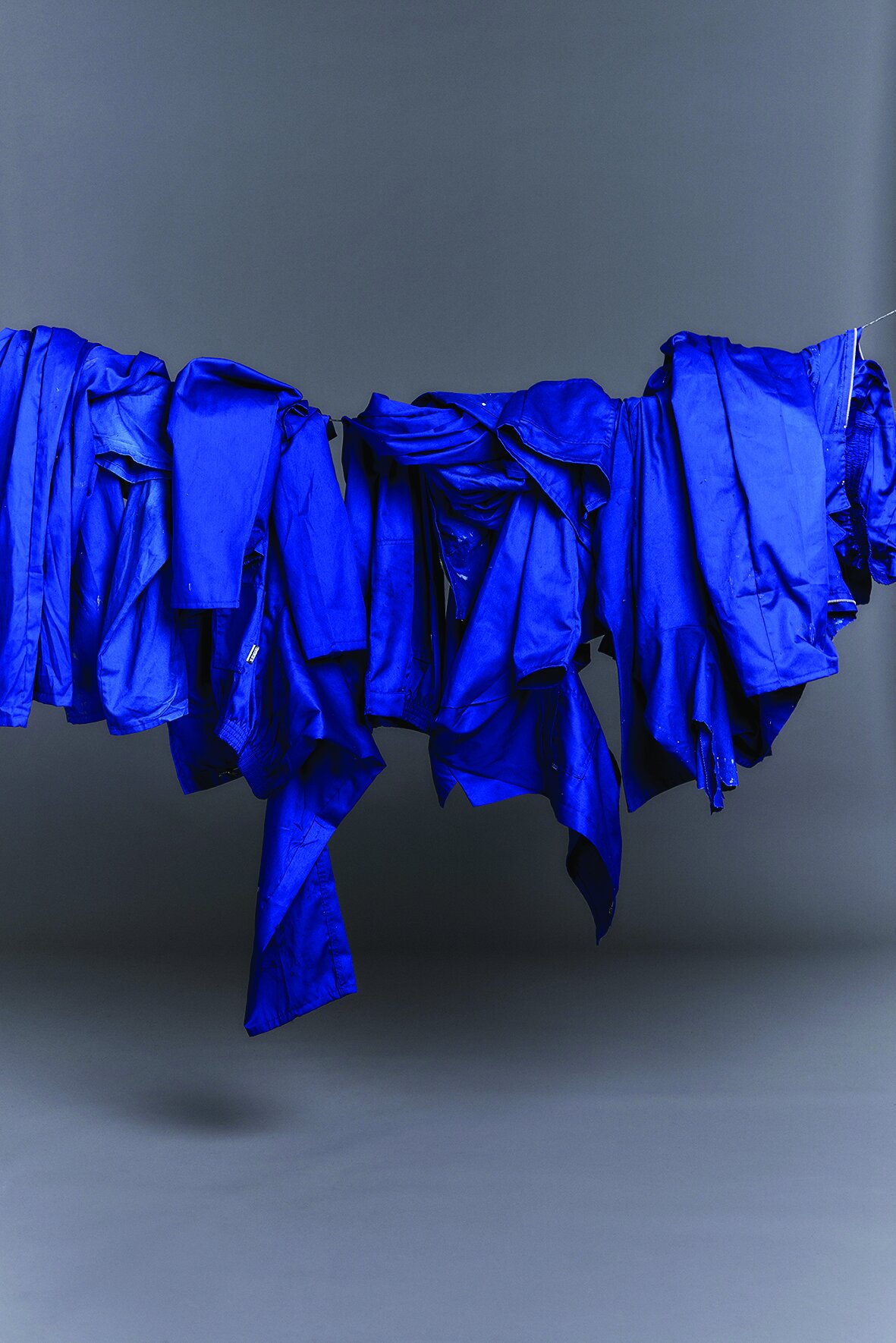


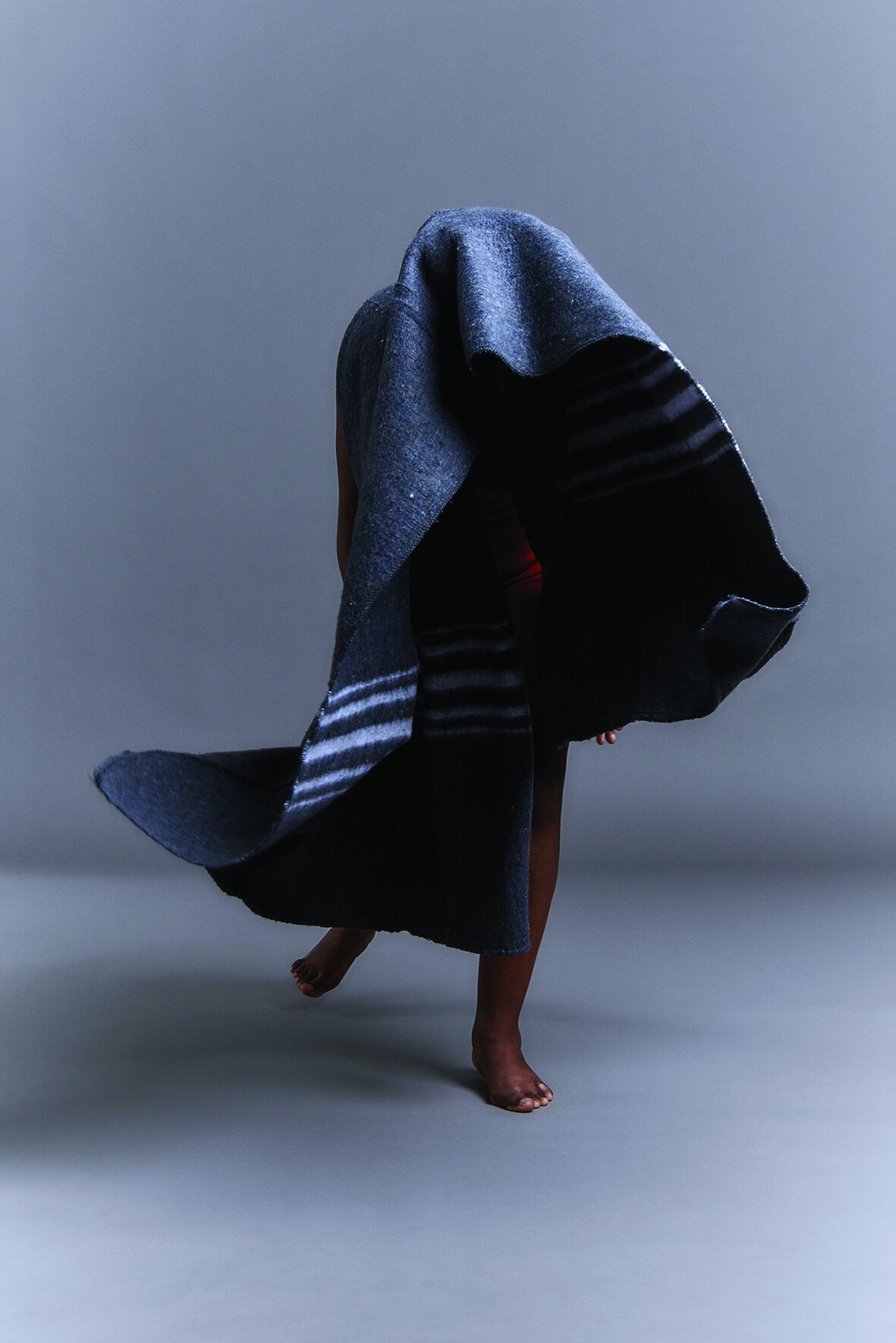
Interview by Mayi-Arts. All pictures are courtesy of Nobukho Nqaba








